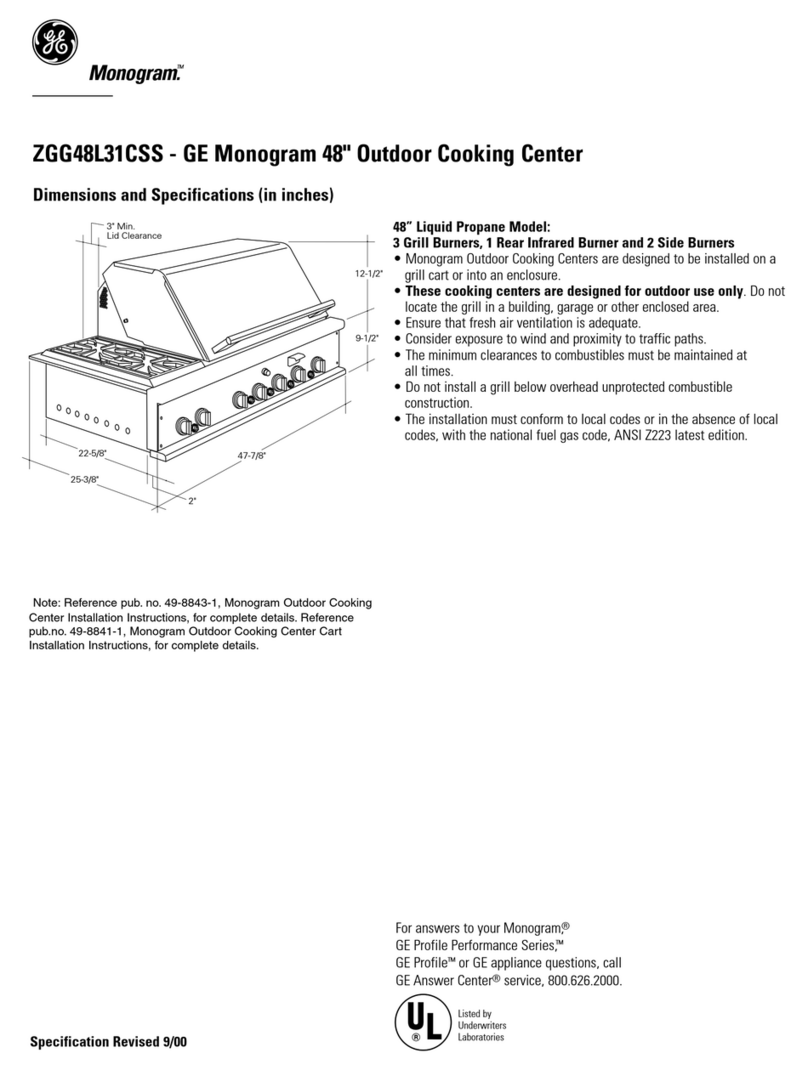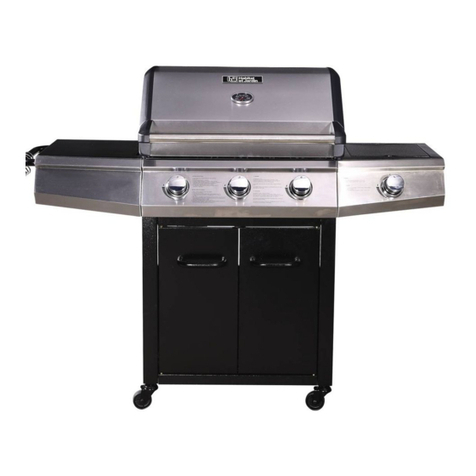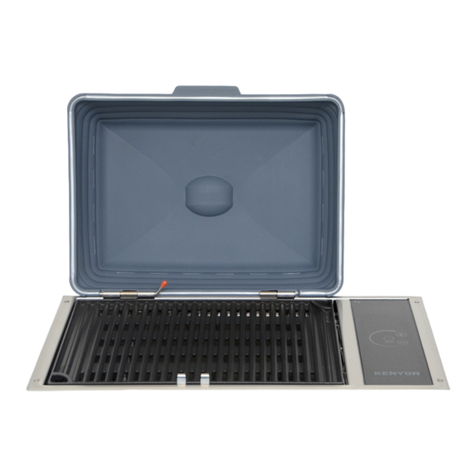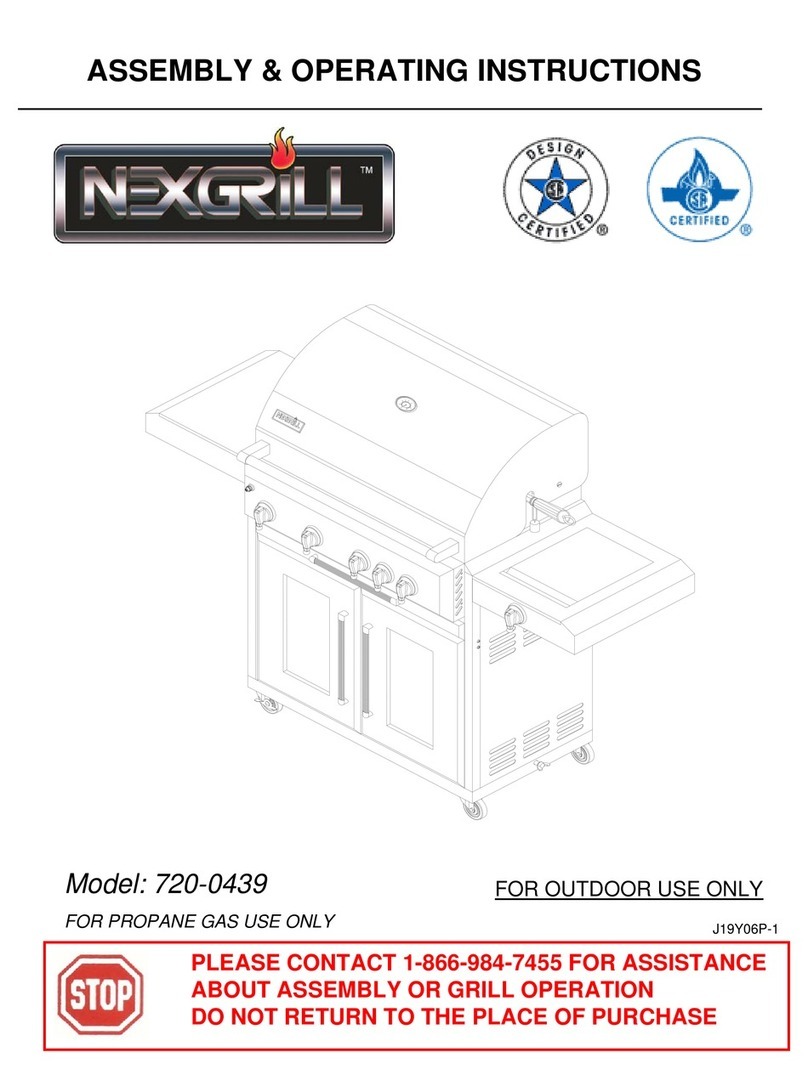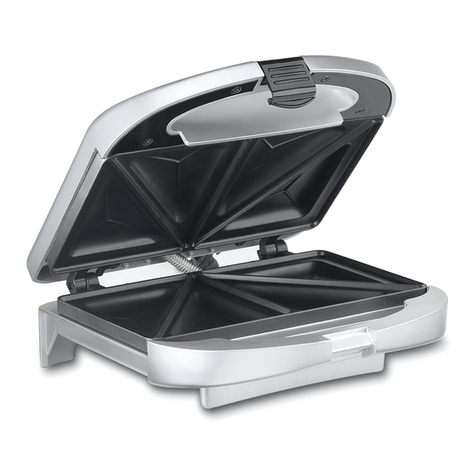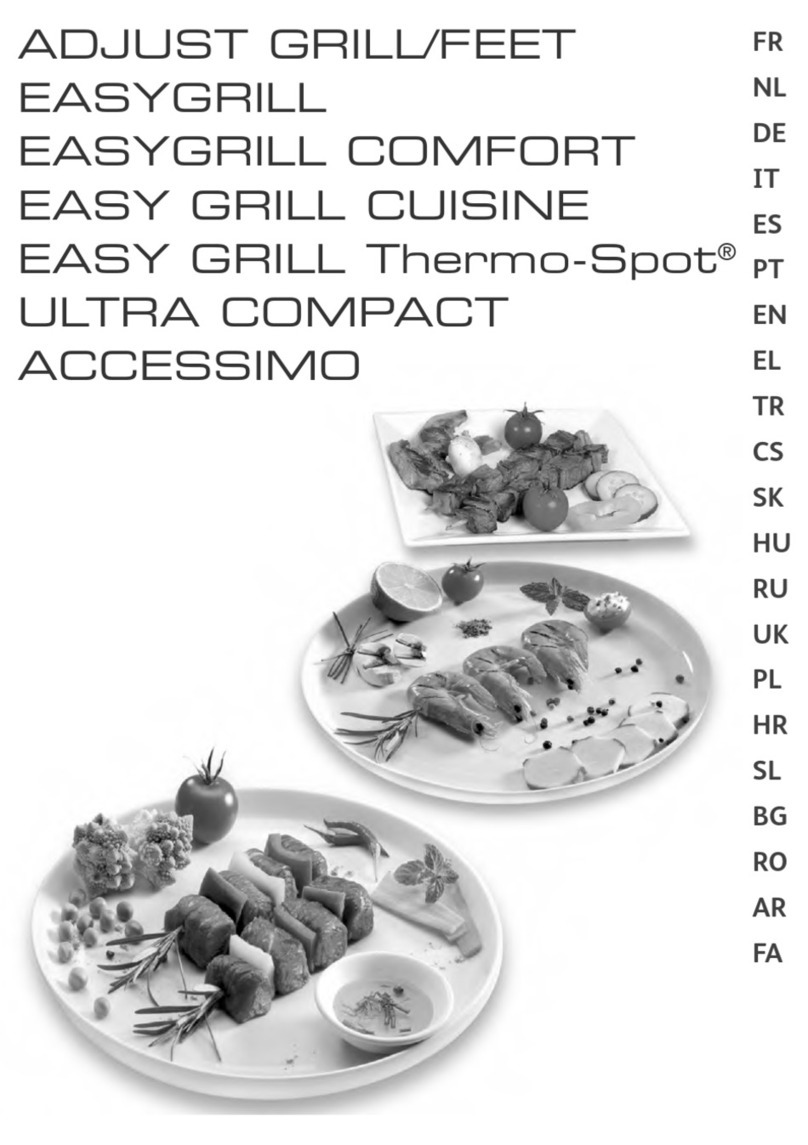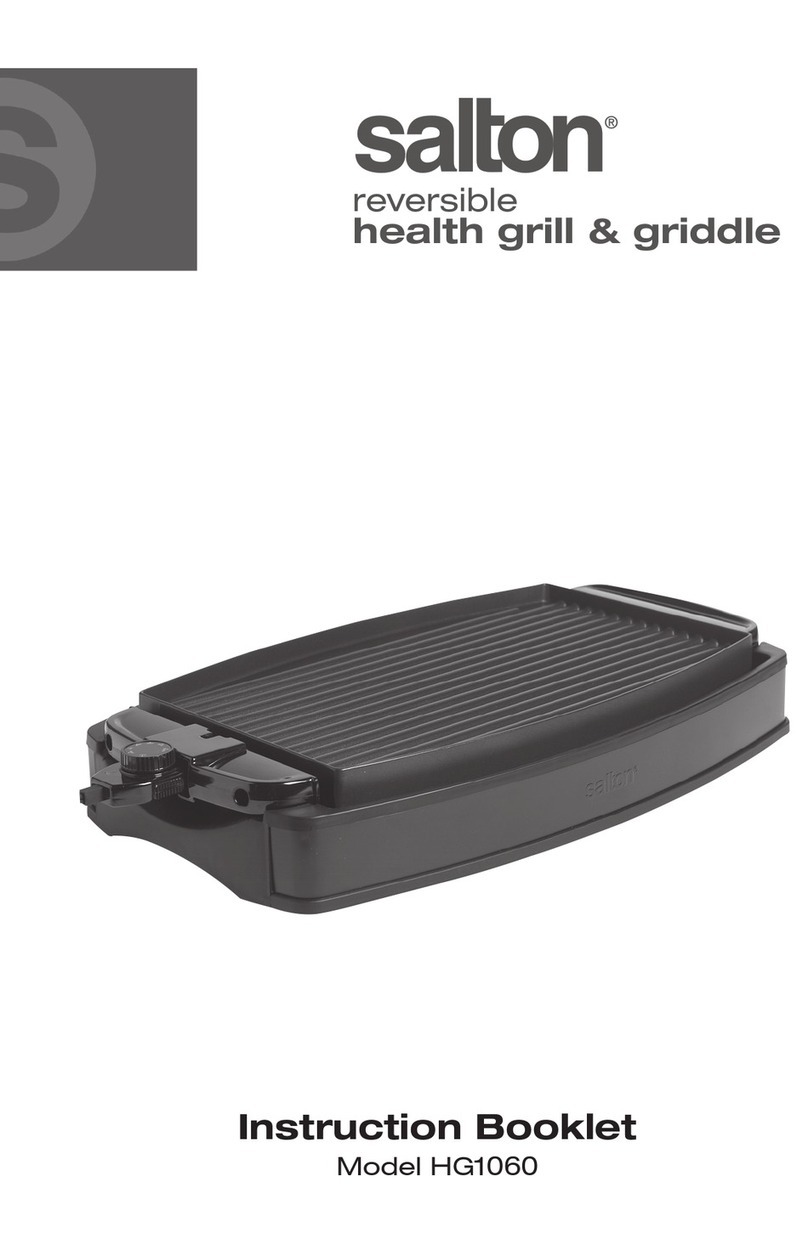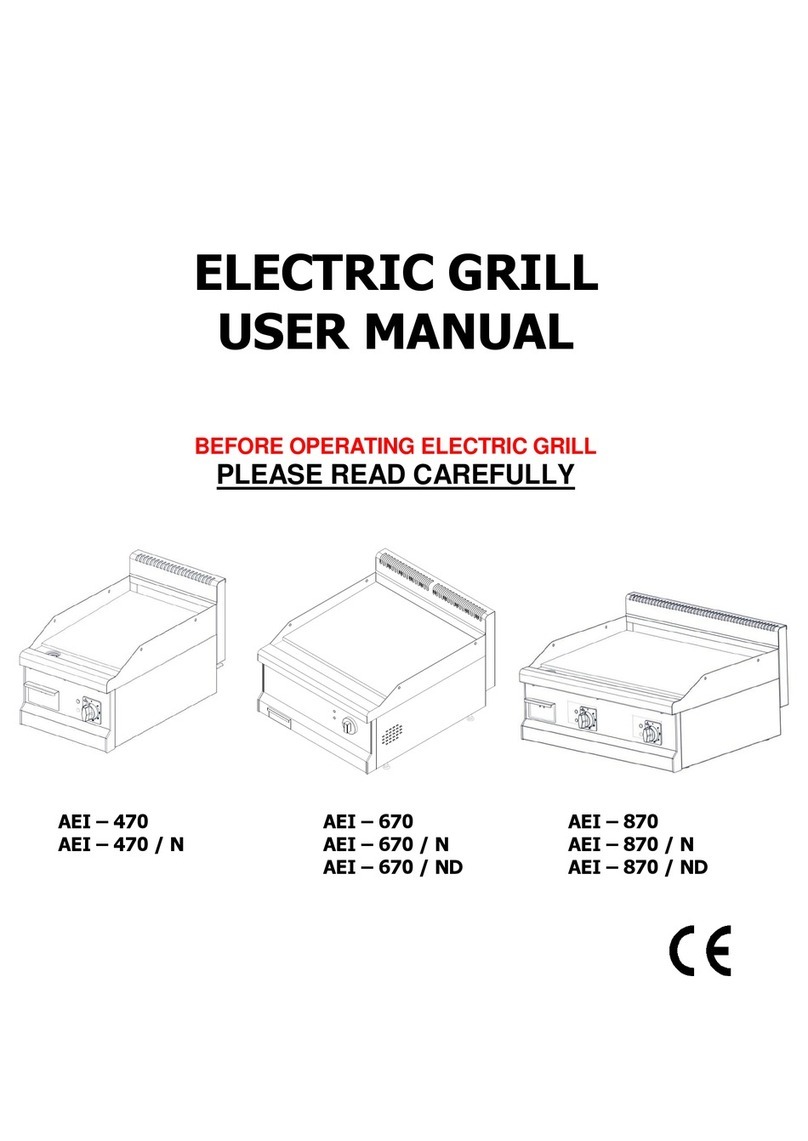Vulcan-Hart VTEC14 User manual

©ITW Food Equipment Group, LLC
3600 North Point Blvd.
Baltimore, MD 21222
RETAIN THIS MANUAL FOR FUTURE USE
FORM F38330 (6-17)
INSTALLATION & OPERATION MANUAL
GAS INFRARED CHARBROILER
MODELS
VTEC14
VTEC25
VTEC36
VTEC48
VTEC60
VTEC36
For additional information on Vulcan or to locate an authorized parts and
service provider in your area, visit our website at www.vulcanequipment.com

- 2-
IMPORTANT FOR YOUR SAFETY
THIS MANUAL HAS BEEN PREPARED FOR PERSONNEL QUALIFIED TO
INSTALL GAS EQUIPMENT, WHO SHOULD PERFORM THE INITIAL FIELD
START-UP AND ADJUSTMENTS OF THE EQUIPMENT COVERED BY THIS
MANUAL.
POST IN A PROMINENT LOCATION THE INSTRUCTIONS TO BE FOLLOWED IN
THE EVENT THE SMELL OF GAS IS DETECTED. THIS INFORMATION CAN BE
OBTAINED FROM THE LOCAL GAS SUPPLIER.
IMPORTANT
IN THE EVENT A GAS ODOR IS DETECTED, SHUT
DOWN UNITS AT MAIN SHUTOFF VALVE AND
CONTACT THE LOCAL GAS COMPANY OR GAS
SUPPLIER FOR SERVICE.
FOR YOUR SAFETY
DO NOT STORE OR USE GASOLINE OR OTHER
FLAMMABLE VAPORS OR LIQUIDS IN THE VICINITY OF
THIS OR ANY OTHER APPLIANCE.
IN THE EVENT OF A POWER FAILURE, DO NOT
ATTEMPT TO OPERATE THIS DEVICE.
Improper installation,
adjustment, alteration, service or maintenance
can cause property damage, injury, or death.
Read the installation, operating and maintenance
instructions thoroughly before installing or
servicing this equipment.

- 3-
INSTALLATION, OPERATION AND CARE OF
GAS COUNTERTOP CHARBROILERS
GENERAL
Gas Infrared Charbroilers are designed for commercial use only and feature fast, efficient
gas heat. Each burner is controlled by an adjustable gas valve. Emitter panels are
located directly above each burner to maintain uniform temperature and provide infrared
cooking. The emitter panels will need to be replaced, depending upon your menu and
hours of operation. Emitter panels and stainless steel cooking grids are easily removed
for cleaning when cool. A crumb tray is provided to collect fat run-off and debris; it opens
to the front for inspection or drain-off.
Model
Number of Burners
BTU/hr Input Rating
VTEC14
1
22,000
VTEC25
2
44,000
VTEC36
3
66,000
VTEC48
4
88,000
VTEC60
5
110,000
INSTALLATION
UNPACKING
This charbroiler was inspected before leaving the factory. The carrier assumes full responsibility for the
safe delivery upon acceptance of the shipment. Check for possible shipping damage immediately after
receipt.
If the charbroiler is found to be damaged, complete the following steps:
1. Carrier must be notified within 5 business days of receipt.
2. Carrier’s local terminal must be notified immediately upon discovery (note time, date, and
who was spoken to), and follow up and confirm with written or electronic communication.
3. All original packing materials must be kept for inspection purposes.
4. The charbroiler cannot have been moved, installed, or modified.
5. Notify Vulcan Customer Service immediately at 800-814-2028.
.
Carefully unpack your charbroiler and make sure that no parts are discarded with
packaging material. A pressure regulator designed to operate with the broiler has been
supplied and must be installed before the charbroiler is placed into service (Refer to GAS
PRESSURE REGULATOR INSTALLATION in this manual).
Before installing, verify that the type of gas (natural or propane) and the clearance
dimensions agree with the specifications on the rating plate which is located on the upper
front corner on the right side.

- 4-
LOCATION
The installation location must be kept free and clear of combustibles. Do not obstruct the
flow of combustion and ventilation air. DO NOT install the charbroiler adjacent to fryers
unless following the provisions detailed by local codes and/or the applicable sections of
ANSI-Z223.1/NFPA #54 (latest edition) and NFPA #96 (latest edition) in the United States
of America or CAN/CSA 149.1 (latest edition) and CAN/CSA149.2 (latest edition) in
Canada.
Sufficient air should be allowed to enter the room to compensate for the amount of air
removed by any ventilating system and for combustion of the gas burners. Do not
obstruct the air flow into and around the appliance. Do not obstruct the flow of flue gases
through and above the broiler's cooking grids. Position the broiler in its final location.
Check that there are sufficient clearances to service the broiler and to make the required
gas supply connection(s). Provide 36" clearance at the front for cleaning, maintenance,
service and proper operation.
This broiler is for use in non-combustible locations only. Installation in combustible
locations is prohibited unless following the provisions detailed by local codes and/or the
applicable sections of ANSI-Z223.1/NFPA #54 (latest edition) and NFPA #96 (latest
edition) in the United States of America or CAN/CSA 149.1 (latest edition) and
CAN/CSA149.2 (latest edition) in Canada and approved by the authority having
jurisdiction.
Minimum clearances to non-combustible walls are 0" to the rear and 0" to the sides.
INSTALLATION CODES AND STANDARDS
The Charbroiler must be installed in accordance with:
In the United States of America:
1. State and local codes.
2. National Fuel Gas Code, ANSI-Z223.1/NFPA #54 (latest edition). This shall include but
not be limited to: NFPA #54 Section 10.3.5.2 for Venting. Copies may be obtained
from The American Gas Association Accredited Standards Committee Z223, @ 400
N. Capital St. NW, Washington, DC 20001 or the Secretary Standards Council, NFPA,
1 Batterymarch Park Quincy, MA 02169-7471
NOTE: In the Commonwealth of Massachusetts
All gas appliances vented through a ventilation hood or exhaust system equipped with
a damper or with a power means of exhaust shall comply with 248 CMR.
3. NFPA Standard # 96 Vapor Removal from Cooking Equipment, latest edition, available
from the National Fire Protection Association, Batterymarch Park, Quincy, MA 02269.
In Canada:
1. Local codes.
2. CAN/CSA-B149.1 Natural Gas Installation (latest edition)
3. CAN/CSA-B149.2 Propane Installation Code (latest edition), available from the
Canadian Gas Association, 178 Rexdale Blvd., Etobicoke, Ontario, Canada M9W 1R3

- 5-
KEY COMPONENTS
The charbroiler
and its parts are hot. Use care
when operating, cleaning or
servicing the charbroiler.
Cooking Grids –The cooking grids
should always be in place and properly
seated on the emitter panels during
operation. Wash grids thoroughly with
soap and water solution and rinse
before first use.
Crumb tray –The crumb tray is the
removable pan that catches any debris
that falls from the broiling area. The
crumb trays should be pushed all the
way in while the unit is operation.
Emitter Panel –The charbroiler must
never be operated without the emitter
panels in place. The emitter panels
protect the burner from food drippings
and debris. Operating the burner without
the emitter panels in place will cause
poor performance and clogging of the
burner ports. The emitter panels
disperse energy and facilitate infrared
cooking.
The emitter panels should rest on top of
the side burner tabs and inside of the
front and rear burner tabs over each
burner. The emitter panels should be
placed in position with the flanged
edges pointing upwards. See Fig. 2.
Emitter panels are consumable.
The emitter panels will need to be
replaced, depending upon your menu
and hours of operation.
Cooking Grid
Fig. 1
Emitter Panel
Crumb Tray
Burner
Fig. 2
Emitter Panel In Place
Emitter Panel Flanges
Emitter Panel
Side Burner Tabs
Front/Rear Burner Tabs
Front/Rear Burner Tabs

- 6-
LEVELING
It is important that the charbroiler is level front to back and left to right. Areas of uneven
heat distribution will occur on an unleveled unit. The charbroiler is equipped with
adjustable legs. Turn the feet at the bottom of the legs to adjust to level. The unit should
be rechecked for level anytime it has been moved.
VENTILATION HOOD
The broiler should be installed under a suitable ventilation hood. For safe operation and
proper ventilation, keep the space between the charbroiler and vent hood free from any
obstructions.
GAS CONNECTION
The data plate on the lower right side of the charbroiler indicates the type of gas your unit
is equipped to burn. DO NOT connect to any other gas type.
All gas supply connections and any pipe joint compound must be resistant to
the action of propane gases.
Purge the supply line to clean out any dust, dirt, or any foreign matter before connecting
the line to the unit.
Codes require that a gas shut-off valve be installed in the gas line ahead of the
charbroiler. The gas supply line must be at least the equivalent of ¾” iron pipe.
A pressure regulator is supplied and must be installed outside of the broiler when making
the gas supply connection. Standard orifices are set for 4"WC (Water Column) for
Natural Gas —10"WC (Water Column) for Propane. Use the 1/8” pipe tap on the burner
manifold for checking pressure. Make sure the gas piping is clean and free of
obstructions, dirt, and piping compound.
An adequate gas supply is necessary. Undersized or low pressure lines will restrict the
volume of gas required for satisfactory performance. A minimum supply pressure of 7"
W.C. for natural gas and 11" W.C. for propane gas is recommended. With all units
operating simultaneously, the manifold pressure on all units should not show any
appreciable drop.
When testing the gas supply piping system, if test pressures exceed ½ psig (3.45 kPa),
the charbroiler and its individual shutoff valve must be disconnected from the gas supply
piping system. When test pressures are ½ psig (3.45 kPa) or less, the charbroiler must
be isolated from the gas supply piping system by closing its individual manual shut-off
valve during any pressure testing of the system.

- 7-
Prior to lighting, check all joints in the gas supply line for leaks.
Use soap and water solution. Do not use an open flame.
GAS PRESSURE REGULATOR INSTALLATION
Gas regulator pressure is preset at 4” Water Column (W.C.) for natural gas, and 10” W.C.
for propane gas. Minor adjustments may be required based on site specific gas pressure.
Install the regulator as close to the broiler on the gas supply line as possible. Make sure
that the arrow on the underside of the regulator is oriented in the direction of gas flow to
the broiler (Fig. 3) and the regulator is positioned with the vent plug and adjustment
screw upright (Fig. 4).
Fig. 3
Fig. 4
The minimum supply pressure (upstream of the regulator) should be 7-9” W.C. for natural
gas and 11-12” W.C. for propane gas. At no time should the charbroiler be connected to
supply pressure greater than ½ psig (3.45 kPa) or 14” W.C.
CASTER EQUIPPED CHARBROILERS
Charbroilers mounted on stands with casters must use a flexible connector (not supplied)
that complies with the Standard for Connectors for Movable Gas Appliances, ANSI Z21.69
• CSA 6.16 and a quick-disconnect device that complies with the Standard for Quick-
Disconnect Devices for use With Gas Fuel, ANSI-Z21.41 • CSA 6.9. In addition, adequate
means must be provided to limit movement of the broiler without depending on the
connector and the quick-disconnect device or its associated piping to limit broiler
movement. Attach the restraining device at the rear of the charbroiler. If disconnection of
the restraint is necessary, turn off the gas supply before disconnection. Reconnect the
restraint prior to turning the gas supply on and return the charbroiler to its installation
position.

- 8-
OPERATION
The charbroiler and its parts are hot. Use care when operating,
cleaning or servicing the charbroiler.
BURNER LIGHTING
The burners should be left on the maximum (MAX) setting for most efficiency when
cooking. The burners may be turned to the minimum (MIN) setting during slow periods to
save energy. See Fig. 6.
The VTEC charbroiler does not have a pilot
and each burner lights directly from a spark
igniter or from an outside ignition source (such
as a lit taper, long handle lighter, etc).
LIGHTING BURNER WITH SPARK IGNITER
1. Turn the main gas shut-off valve and the
individual burner control knobs to the OFF
position (clockwise until stops). Wait 5
minutes.
2. Push and turn the burner control knob to the
MAX setting (counterclockwise to vertical/90°
position) on the burner you intend to light.
(Fig. 5)
3. Immediately, while viewing through the
burner sight hole, turn the igniter knob
clockwise until you hear a click (approx. ¼
turn) and see the spark. The burner should
ignite immediately and flames should be
visible through the burner sight hole.
4. If the burner fails to light immediately,
repeat step 3, two more times. If the burner
has still not ignited at this point, turn the
main gas shut-off valve and all burner
valves to the OFF position (clockwise until
stops) and proceed with manual burner
lighting instructions on following page.
5. Repeat steps 2-4 until all burners are lit.
Turn on one burner control knob at a time
and ensure burner is lit before proceeding
to light the next burner.
Fig. 6
Fig. 5
Burner Sight Hole
Burner Control Knob
Igniter Knob
OFF MAXIMUM MINIMUM

- 9-
TO COMPLETELY SHUTDOWN THE BURNERS
For complete shutdown: Turn the main gas supply valve OFF. Make sure all individual
burner valves are OFF (turned completely clockwise until stops).
PREHEATING THE CHARBROILER
Allow the charbroiler to preheat for 20 minutes on the maximum (MAX) setting. Rub
grates with cooking oil before using to help reduce sticking.
LIGHTING BURNER MANUALLY
1. Turn the main gas shut-off valve and the
individual burner control knobs to the OFF
position (clockwise until stops). Wait 5
minutes.
2. Apply a flame from an outside ignition source
(such as a lit taper, long handle lighter, etc)
directly to the gap between the bottom of the
emitter panel and the top of the intended
burner box at the front of the unit. See Fig. 7.
3. Push and turn the burner control knob to the
MAX setting (counterclockwise to vertical/90°
position) on the burner you intend to light.
(Fig. 8)
4. View through the burner sight hole (Fig.8) to
ensure the burner has lit.
5. If the burner fails to light within 4 seconds of
applying flame to the directed area, turn the
main gas shut-off valve and all burner
valves to the OFF position (clockwise until
stops). Contact an authorized service
contractor.
6. Repeat steps 2-4 until all burners are lit.
Turn on one burner control knob at a time
and ensure burner is lit before proceeding
to light the next burner.
Burner Sight Hole
Burner Control Knob
Fig. 8
Cutaway View
Fig. 7
Outside Ignition Source
Emitter Panel
Gap
Burner Box

- 10 -
CLEANING
Never leave emitter panels wet after cleaning. Leaving panels wet after
cooking or cleaning may accelerate corrosion process and result in premature failure.
WEEKLY
When cool, remove cooking grids, emitter panels and heat shield. Clean and vacuum any accumulated
debris from inside burner boxes. Clean inside chassis area anywhere fat, grease, or food can
accumulate. Clean heat shield while removed (Fig. 10). Repeat weekly process more often as needed.
The charbroiler and its
parts are hot. Use care when operating,
cleaning or servicing the charbroiler.
Scrape cooking grids during broiling with a
stainless steel scraper or stainless steel wire
brush to keep the grates clean. Do not allow
debris to accumulate on the grates. (Fig. 9)
Top grates may be immersed in cleaning
compound overnight. In the morning, rinse
with hot water to remove any residues of
cleaning compound.
Stainless steel surfaces may be cleaned using
damp cloth with mild detergent and water
solution. Clean heavy, baked on grease and
splatter that do not respond to normal cleaning
by using cleaning solution with a Scotch-
BriteTM pad. Rub with the grain of the surface
–do not rub in a circular motion.
DAILY
After cooking, allow unit to run on MAX setting
for 10 minutes before shutting OFF.
This will make cleaning debris from the emitter
panels easier when they cool down.
When cool, remove cooking grids and emitter
panels, clean places where fat, grease, or food
can accumulate. Brush or use scraper to
remove any accumulated debris from emitter
panel surfaces. Be careful to keep inside
burner boxes clear of debris. Remove crumb
tray when cool and empty. (Fig. 10)
Fig. 10
Cooking Grid
Emitter Panel
Crumb Tray
Heat Shield
Inside
Burner Box
Fig. 9

- 11 -
Never cover surface of unit with pans or other objects in attempt to “burn off”
or clean debris from unit. This will cause a buildup of heat that can potentially damage
and warp components of the charbroiler. Do not cover surfaces with aluminum foil as this
may block or disrupt the designed air flow pattern and affect performance.
MAINTENANCE
The charbroiler and its parts are hot. Use care when operating,
cleaning or servicing the charbroiler.
VENT SYSTEM
At least twice a year the exhaust hood (venting system) should be examined and cleaned.
LUBRICATION
All valves, at the first sign of sticking, should be lubricated by a trained technician using
high temperature grease.
EMITTER PANELS
Emitter panels are consumable.
The emitter panels will need to be replaced, depending upon your menu and hours of
operation. Replace emitter panels if warped or holes appear.
SERVICE
Contact your local Service Contractor for any repairs or adjustments needed on this
equipment. For a complete listing of service and parts depots refer to
www.vulcanequipment.com. When calling for service, the following information should be
available from the appliance identification plate: Model Number and Serial Number.

- 12 -
TROUBLE SHOOTING
Uneven heating
A. Burner valves improperly adjusted
B. Fluctuating gas pressure
C. Appliance is not level
D. Emitter panels are not properly seated or damaged
E. Emitter panels are excessively dirty
Too much top heat
A. Faulty hood ventilation
C. Overrated gas pressure
D. Unit is excessively dirty
E. Emitter panels are not properly seated or damaged
Uneven heat side to side
A. Burner valves improperly adjusted
B. Appliance is not level side to side
C. Crumb tray is not pushed all the way in
D. Emitter panels are not properly seated or damaged
E. Emitter panels are excessively dirty
Uneven heat front to back
A. Appliance is not level front to back
B. Faulty hood ventilation
C. Crumb tray is not pushed all the way in
D. Emitter panels are not properly seated or damaged
E. Emitter panels are excessively dirty
F. Designed air flow pattern obstructed
Burner not lighting
A. Check that igniter electrode is sparking when igniter
knob is turned clockwise
B. Check for damaged, loose or dirty igniter wires, igniter
and electrode
C. Burner valve not on MAX setting
D. Gas pressure too low
E. Inside burner box or burner venturi excessively dirty
Burner flames too low
A. Burner valves improperly adjusted
B. Gas pressure too low
C. Inside burner box or burner venturi excessively dirty
D. Clogged burner orifice
Burner flames to high
A. Emitter panels are not properly seated or damaged
B. Gas pressure too high
Fluctuating gas pressure
A. Checked for clogged vent on regulator

- 13 -
ACCESSORY INSTALLATION
The charbroiler and its parts are hot. Use care when operating,
cleaning or servicing the charbroiler.
1
2

- 14 -
4
3

©ITW Food Equipment Group, LLC
3600 North Point Blvd.
Baltimore, MD 21222
GARDER CE MANUEL POUR UNE
UTILISATION FUTURE
FORM F38330 (6-17)
MANUEL D'INSTALLATION ET D'EMPLOI
GRIL INFRAROUGE À GAZ
MODÈLES
VTEC14
VTEC25
VTEC36
VTEC48
VTEC60
VTEC36
Pour obtenir des renseignements supplémentaires au sujet de Vulcan-Hart
ou pour trouver un fournisseur de pièces et service autorisé dans votre
région, veuillez visiter notre site web à www.vulcanequipment.com

- 2-
IMPORTANT POUR VOTRE SÉCURITÉ
CE MANUEL A ÉTÉ CONÇU POUR LE PERSONNEL APTE À INSTALLER UN
ÉQUIPEMENT AU GAZ, QUI DOIT EFFECTUER LA MISE EN MARCHE ET LES
RÉGLAGES INITIAUX DE L’ÉQUIPEMENT DONT IL S’AGIT DANS CE MANUEL.
PLACEZ DANS UN ENDROIT IMPORTANT LES INSTRUCTIONS QUI DOIVENT
ÊTRE SUIVIES AU CAS OÙ UNE ODEUR DE GAZ SERAIT DÉTECTÉE. VOUS
POUVEZ DEMANDER CES RENSEIGNEMENTS AU FOURNISSEUR DE GAZ
LOCAL.
IMPORTANT
AU CAS OÙ UNE ODEUR DE GAZ SERAIT
DÉTECTÉE, FERMEZ LE ROBINET D’ARRÊT
PRINCIPAL DES APPAREILS ET COMMUNIQUEZ
AVEC VOTRE COMPAGNIE DE GAZ OU VOTRE
FOURNISSEUR DE GAZ LOCAL AFIN D’OBTENIR
DU SERVICE.
POUR VOTRE SÉCURITÉ
NE PAS ENTREPOSER OU UTILISER DE L’ESSENCE OU
AUTRES VAPEURS OU LIQUIDES INFLAMMABLES À
PROXIMITÉ DE CET APPAREIL OU TOUT AUTRE
APPAREIL.
EN CAS DE PANNE DE COURANT, NE PAS
TENTER DE FAIRE FONCTIONNER CET
APPAREIL.
Une installation, un
ajustement, une modification, un service ou un
entretien inapproprié peut causer du dommage
matériel, une blessure ou la mort. Lire
minutieusement les instructions d’installation,
d’emploi et d’entretien avant d’installer ou de se
servir de cet équipement.
MISE EN GARDE

- 3-
INSTALLATION, FONCTIONNEMENT ET ENTRETIEN
DES GRILS DU COMPTOIR À GAZ
GÉNÉRAL
Les grils infrarouges à gaz sont uniquement destinés à l'usage commercial et produisent
une chaleur instantanée et efficace. Chaque brûleur est contrôlé par une soupape à gaz
réglable. Les panneaux émetteurs sont situés directement au-dessus de chaque brûleur
pour garder une température uniforme et produire une cuisson à infrarouge. En fonction
de votre menu et des heures de fonctionnement, les panneaux émetteurs devront être
remplacés. Les panneaux émetteurs et les grils de cuisson en acier inoxydable s'enlèvent
facilement pour le nettoyage, après refroidissement. Un ramasse-miettes est fourni pour
recueillir la graisse et les débris; il s'ouvre à l'avant pour la vérification ou le nettoyage.
Modèle
Nombre de brûleurs
Débit calorifique BTU/h
VTEC14
1
22,000
VTEC25
2
44,000
VTEC36
3
66,000
VTEC48
4
88,000
VTEC60
5
110,000
INSTALLATION
DÉBALLAGE
Ce gril a été inspecté avant de quitter l’usine. En acceptant sa livraison, le transporteur prend
l’entière responsabilité de le livrer en toute sécurité. Immédiatement après la livraison, vérifiez
s’il a effectivement subi des dommages pendant le transport.
S’il s’avère que le gril a été endommagé, veuillez suivre les procédur es suivantes :
1. Le transporteur doit être averti dans les 5 jours ouvrables suivant la réception.
2. Les gens du terminus local du transporteur doivent être avisés immédiatement lors de la
découverte des dommages (indiquez l’heure, la date et à qui vous avez parlé) et assurez le
suivi en confirmant les faits par écrit ou par communication électronique.
3. Pour fins d’inspection, tout le matériel d’emballage original doit être conservé.
4. Le gril ne doit pas avoir été déplacé, installé ou modifié.
5. Avisez le Service à la clientèle de Vulcan immédiatement en faisant le (800) 814-2028
Déballez soigneusement votre gril et assurez-vous qu’aucune pièce n’a été jetée avec
l’emballage. Un régulateur de pression conçu pour fonctionner avec le brûleur a été
fourni et doit être installé avant que le gril soit mis en service (Consultez INTALLATION
DU RÉGULATEUR DE PRESSION DU GAZ dans ce manuel).
Avant l'installation, vérifiez que le type de gaz (naturel ou propane) et les espaces de
dégagement sont conformes aux normes spécifiées sur la plaque située sur le côté
supérieur avant droit.

- 4-
EMPLACEMENT
Le lieu de l’installation doit être maintenu sans présence de combustibles. N’obstruez
pas la circulation de la combustion ainsi que l’air de ventilation. NE PAS installer le gril
adjacent à une ou des friteuses à moins d’observer les dispositions prévues par les codes
locaux et/ou les sections applicables des normes ANSI-Z223.1/NFPA N° 54 et NFPA N°
96 (éditions les plus récentes) aux États-Unis d'Amérique ou les normes CAN/CSA 149.1
et CAN/CSA149.2 (éditions les plus récentes) au Canada.
Suffisamment d’air devrait entrer dans la pièce afin de compenser la quantité d'air enlevé
par tout système de ventilation et pour la combustion des brûleurs de gaz. Ne pas
obstruer la circulation de l’air à l’intérieur et autour de l’appareil. N'obstruez pas la
circulation des gaz dans les conduits des grils de cuisson du gril. Placez le gril dans son
emplacement définitif. Assurez-vous qu’il y a suffisamment d’espace libre pour entretenir
le gril et effectuer la (les) connexion(s) nécessaire(s) d’alimentation en gaz. Prévoyez un
espace libre de 61 cm à l’avant pour le nettoyage, l’entretien et l’emploi adéquat.
Ce gril est uniquement conçu pour les lieux sans combustibles. Son installation dans des
locaux combustibles est interdite, sauf suivant les dispositions prévues par les codes
locaux et/ou les sections applicables des normes ANSI-Z223.1/NFPA N° 54 et NFPA N°
96 (éditions les plus récentes) aux États-Unis d'Amérique ou les normes CAN/CSA 149.1
et CAN/CSA149.2 (éditions les plus récentes) au Canada, le tout sujet à l’approbation de
l'autorité compétente.
Les espaces minimums pour les parois non combustibles sont de 0 cm à l’arrière et de
0 cm de chaque côté.
CODES ET NORMES D’INSTALLATION
Le gril doit être installé conformément à :
Aux États-Unis d’Amérique :
1. Codes locaux et d’état.
2. National Fuel Gas Code, ANSI-Z223.1/NFPA Nº 54 (dernière édition). Cela doit
comprendre sans être limité à : NFPA No 54 Section 10.3.5.2 pour la ventilation. Vous
pouvez obtenir des copies auprès de l’American Gas Association Accredited
Standards Committee Z223, à 400 N. Capital St. NW, Washington, DC 20001 ou le
Secretary Standards Council, NFPA, 1 Batterymarch Park Quincy, MA 02169-7471
REMARQUE : Dans l’État du Massachusetts
Tous les appareils d’utilisation du gaz aérés grâce à une hotte de ventilation ou un
système d’échappement muni d’une clef de réglage ou avec une moyenne potentielle
d’échappement qui doivent être conformes à 248 CMR.
3. Norme NFPA N° 96 Vapor Removal from Cooking Equipment, dernière édition,
disponible auprès de l'organisme National Fire Protection Association, Batterymarch
Park, Quincy, MA 02269.
Au Canada :
1. Codes locaux.
2. Code d'installation du gaz naturel CAN/CSA-B149.1 (dernière édition)
3. Code d'installation du propane CAN/CSA-B149.2 (dernière édition), disponible auprès
de l’Association Canadienne du Gaz, 178 boul. Rexdale, Etobicoke, Ontario, Canada
M9W 1R3

- 5-
COMPOSANTS PRINCIPAUX
Le gril et ses
pièces sont chauds. Faites attention
lorsque vous employez, nettoyez ou
entretenez ce gril.
Les grilles de cuisson - Les grilles de
cuisson doivent toujours être en place et
correctement fixés sur les panneaux
émetteurs durant le fonctionnement.
Lavez entièrement les grilles avec une
solution d'eau et de savon et rincez
avant la première utilisation.
Ramasse-miettes - Le ramasse-miettes
est le plateau qui recueille tous les
débris qui tombent du gril. Les ramasse-
miettes doivent être complètement
rentrés pendant le fonctionnement de
l'appareil.
Panneau émetteur - Le gril ne doit
jamais fonctionner tant que les
panneaux émetteurs ne sont pas en
place. Les panneaux émetteurs
protègent le brûleur des jus de cuisson
et des débris. Le fait de faire fonctionner
le brûleur sans que les panneaux
émetteurs ne soient en place entraîne
une mauvaise performance et
l'obstruction des brûleurs. Les panneaux
émetteurs répandent l'énergie facilitant
ainsi la cuisson à infrarouge.
Les panneaux émetteurs doivent
s'appuyer sur les fixations des brûleurs
latéraux et dans les fixations des
brûleurs avant et arrière au-dessus de
chaque brûleur. Les panneaux
émetteurs doivent être positionnés avec
les rebords saillants pointés vers le
haut. Voir Fig. 2.
Les panneaux émetteurs sont des
consommables.
En fonction de votre menu et des
heures de fonctionnement, les
panneaux émetteurs devront être
remplacés.
Grille de cuisson
Fig. 1
Panneau émetteur
Ramasse-miettes
brûleur
Fig. 2
Fixations des brûleurs
avant/arrière
Fixations du brûleur latéral
Fixations des brûleurs
avant/arrière
Panneau émetteur en place
Panneau émetteur
Les rebords du panneau
émetteur

- 6-
MISE À NIVEAU
Il est important que le gril soit mis à niveau de l'avant vers l'arrière et de la gauche vers
la droite. Il se produira des zones où la distribution de la chaleur sera inégale dans un
appareil qui n'est pas mis à niveau. Le gril est muni de pattes réglables. Tournez le pied
au bout des pattes pour régler le niveau. Vous devriez vérifier le niveau de cet appareil à
nouveau chaque fois qu'il est déplacé.
HOTTE DE VENTILATION
Le gril devrait être installé sous une hotte de ventilation appropriée. Pour un emploi
sécuritaire et une ventilation adéquate, laissez un espace entre le gril et la hotte à
évacuation libre de toute obstruction.
CONNEXION DU GAZ
La plaque de données sur le côté inférieur droit du gril indique le type de gaz adapté à
votre appareil. NE le raccordez à AUCUN autre type de gaz.
NOTEZ que tout le système de branchement de l'alimentation gaz et les joints de la
tuyauterie doivent être résistants à l'action des gaz propane.
Vider la conduite d’alimentation pour la nettoyer de toute poussière, saleté ou tout autre
corps étranger avant de la connecter à l’appareil.
Les codes exigent que la soupape d’arrêt du gaz soit installée dans la conduite de gaz du
gril. La conduite d’alimentation en gaz doit être au moins l’équivalent d’un tuyau en fer
de 2 cm.
Un régulateur de pression est fourni et doit être installé à l’extérieur du gril lorsque vous
effectuez la connexion d’alimentation en gaz. Les orifices en mince paroi sont établis à
10 cm CE (colonne d’eau) pour le gaz naturel — 25 cm CE (colonne d’eau) pour le
propane. Utilisez le taraud de 0,3 cm (1/8po.) sur la rampe de brûleurs pour vérifier la
pression. Assurez-vous que les conduites de gaz soient propres et libres d'obstructions,
de saleté et de toute pâte à tuyauterie.
Une alimentation adéquate en gaz est requise. Des conduites de dimension insuffisante
ou à basse pression limiteront le volume de gaz nécessaire pour une performance
satisfaisante. On recommande une pression d'alimentation minimum de 18 cm CE pour le
gaz naturel et de 28 cm CE pour le gaz propane. Avec tous les éléments fonctionnant en
même temps, la pression d’admission sur tous les éléments ne devrait pas démontrer une
baisse notable.
Lorsque vous évaluez la tuyauterie de l’alimentation en gaz, si les pressions d’essai
excèdent ½ psi (3,45 kPa), le gril et son robinet d’arrêt individuel doivent être
déconnectés de la tuyauterie de l’alimentation en gaz. Lorsque les pressions d’essai
AVIS
Other manuals for VTEC14
1
This manual suits for next models
4
Table of contents
Languages:
Other Vulcan-Hart Grill manuals

Vulcan-Hart
Vulcan-Hart VACB20 User manual
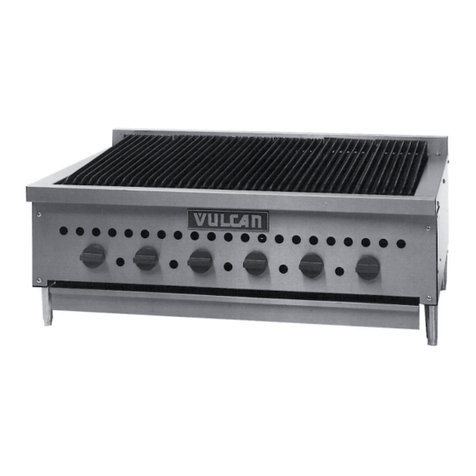
Vulcan-Hart
Vulcan-Hart Vulcan VCCB25 User manual
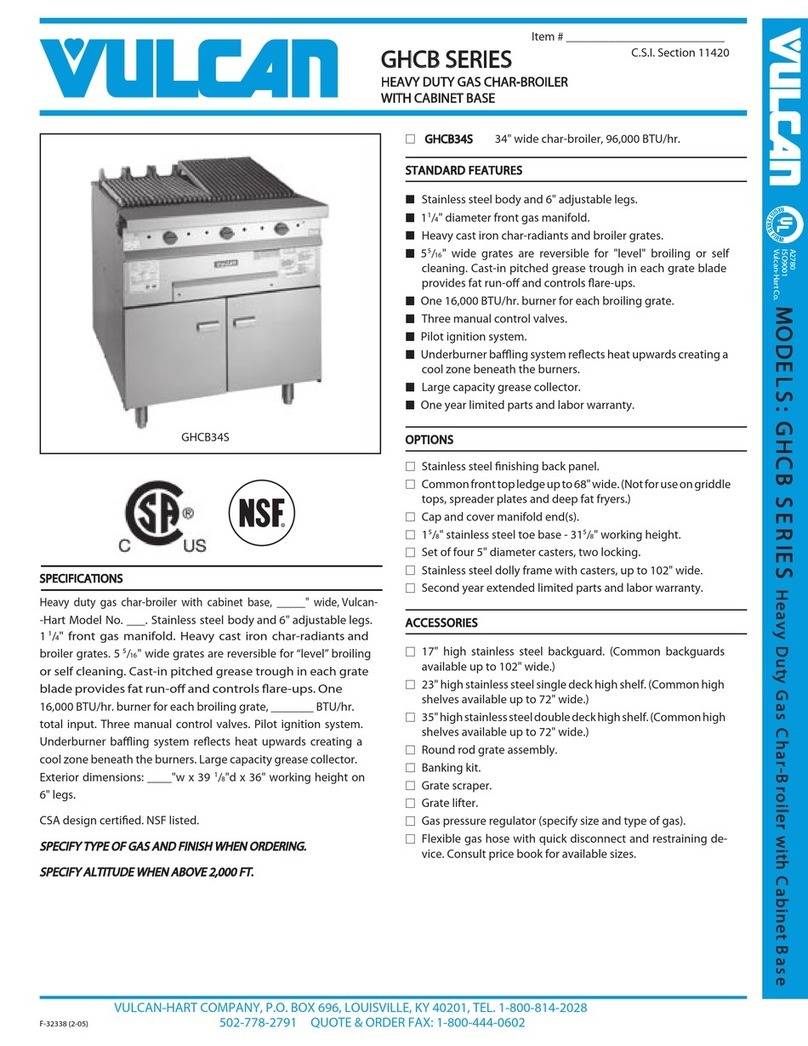
Vulcan-Hart
Vulcan-Hart GHCB34S User manual
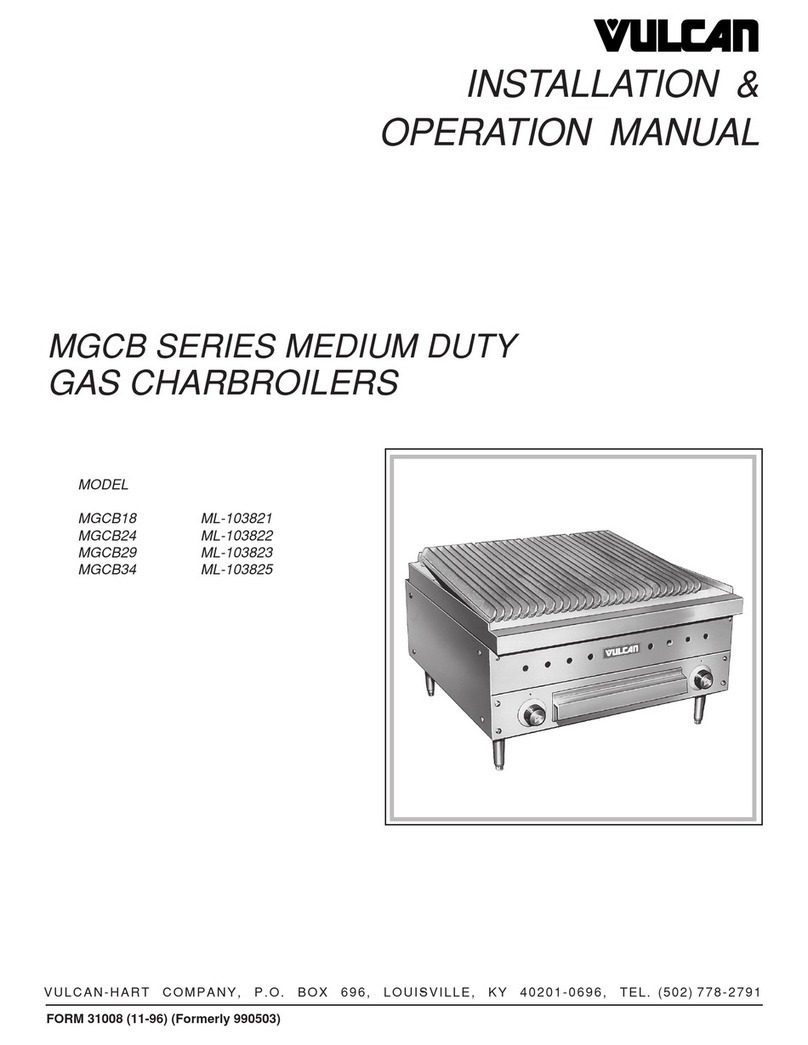
Vulcan-Hart
Vulcan-Hart MGCB18 ML-103821 User manual

Vulcan-Hart
Vulcan-Hart VACB25 User manual

Vulcan-Hart
Vulcan-Hart MG24CB User manual

Vulcan-Hart
Vulcan-Hart Vulcan VCCB25 User manual
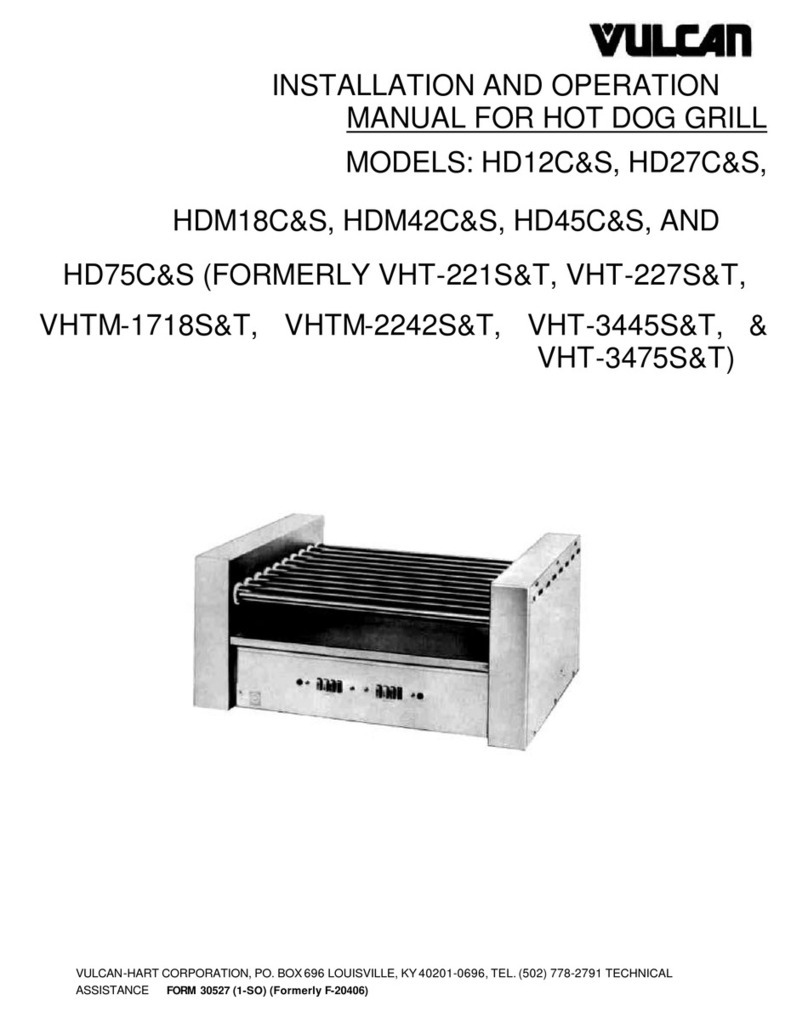
Vulcan-Hart
Vulcan-Hart HD12C Programming manual
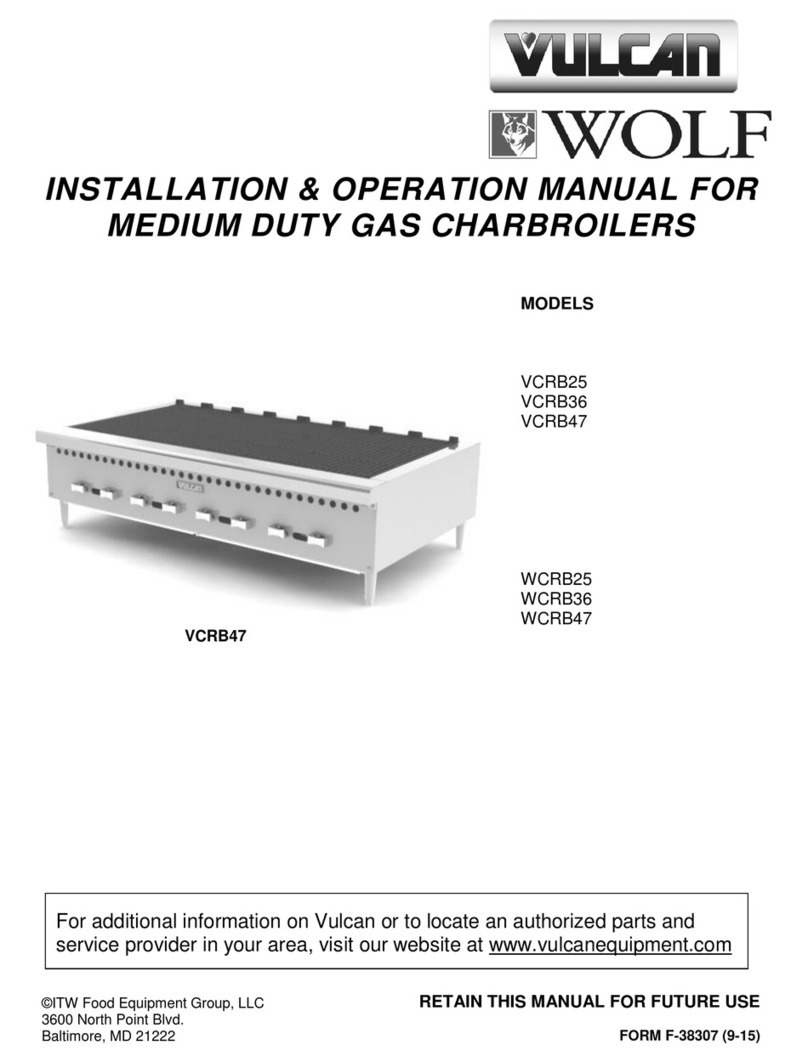
Vulcan-Hart
Vulcan-Hart Wolf VCRB25 User manual
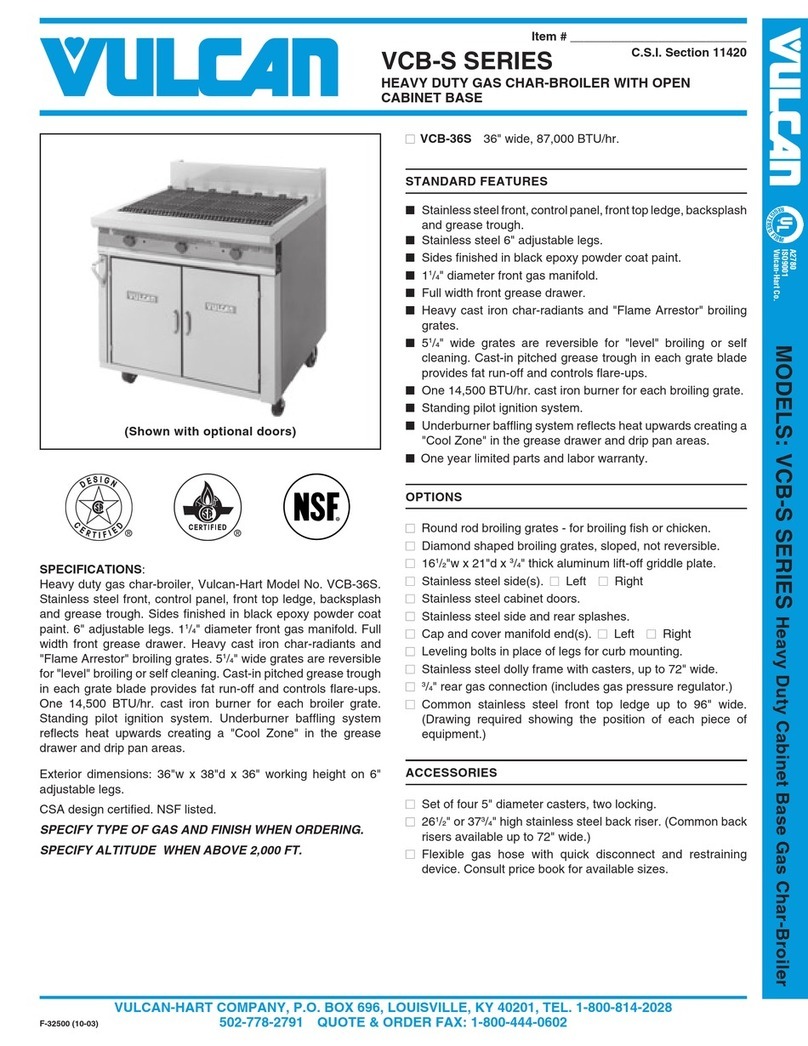
Vulcan-Hart
Vulcan-Hart VCB-S User manual
